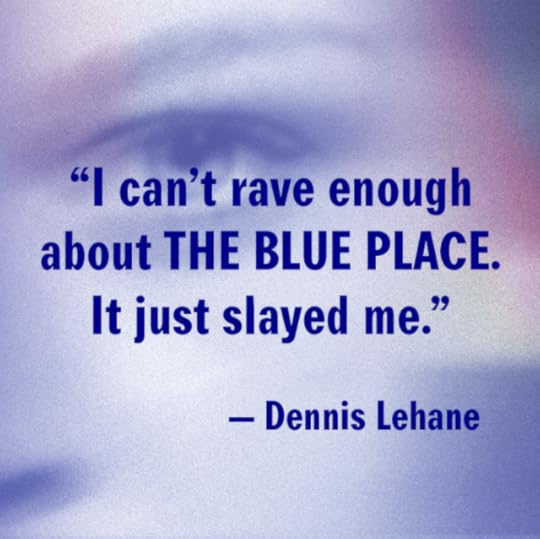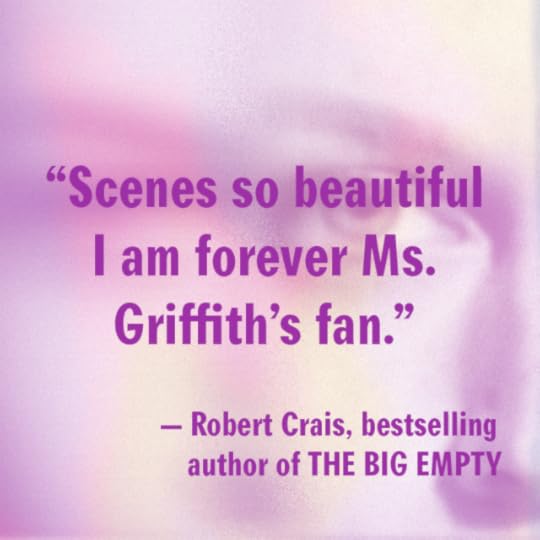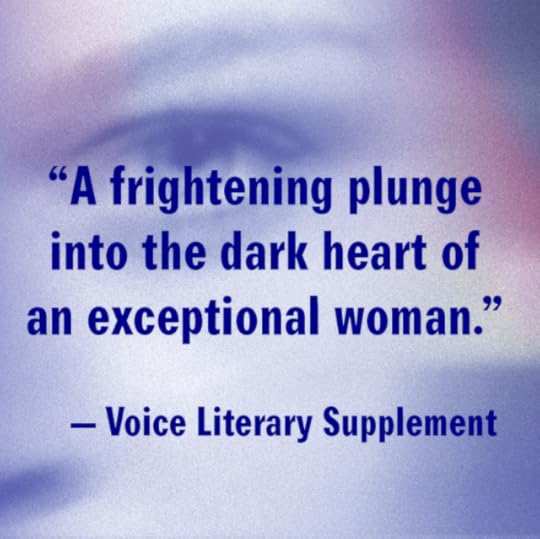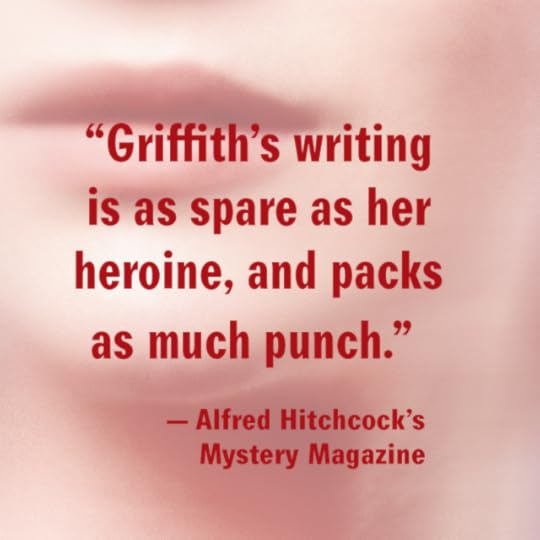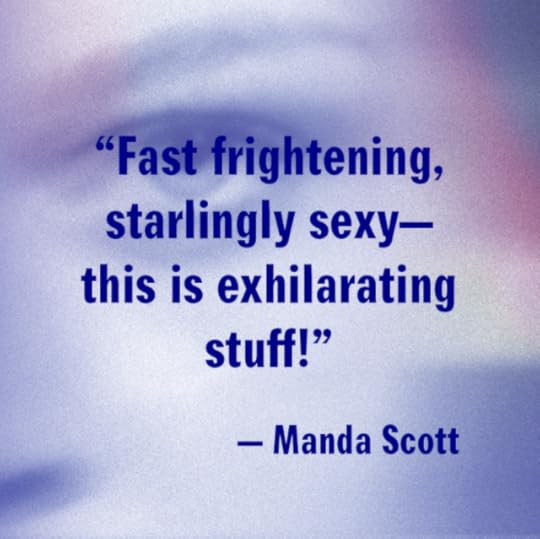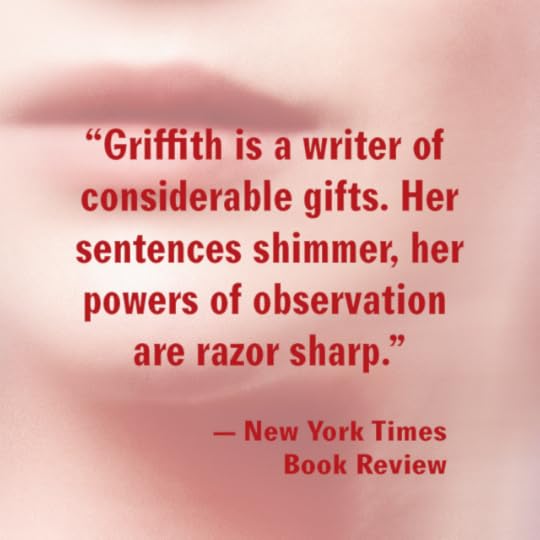Nicola Griffith's Blog, page 3
June 26, 2025
A Miracle Built on a Moment: a 37-year love story in photos
June 26, 1988, East Lansing, MI: I met Kelley and fell instantly in love. I love her still—in some ways more than ever, because I know her better. It’s also the 10th anniversary of Obergefell v Hodges. I’d intended to write a post about that but I find the post I wrote last year says everything I want to say: it explains without explaining just why that Supreme Court decision was so important. So here it is again—I just updated a little and added another picture at the end.
The Moment37 years ago today I met Kelley. 37 years ago today I fell instantly and irrevocably in love. Most people find that difficult to believe. I understand. I’ll say only that if you ever have every cell in your body stop, shiver, and align in one direction like iron filings around a magnet, you will know. It remains the oddest, most powerful and inarguable thing that’s ever happened to me. A done deal, the work of a moment. And absolutely non-negotiable.
37 years later, here we are, living the life that bloomed from that moment. Every day is a miracle.
Does this mean our life together was inevitable and easy? It was not. Against that simple, visceral knowing was ranged every rational, practical and institutional argument in the world.1 So although the connection, commitment, and (so far) life-long bond happened in an instant, it took 18 months to make it possible for me to move from the UK to Kelley in the US, and another 5 years of browbeating the world to make the US State Department declare it to be in the National Interest to grant me, an out lesbian with no money, connections, degree, or job offer, but with a chronic degenerative illness and no visible means of support, a waiver to live permanently in this country.2
37 Years: A PhotostoryI met Kelley in the corridor of a dorm at MSU in East Lansing, Michigan. It was 104º with no air-conditioning. We were there for Clarion—I was their very first foreign student. I’ve told the story elsewhere. But the bottom line was: we had six weeks together and then I had to go back to my life—family, partner, job, mortgage—in the UK with no practical hope of coming back…
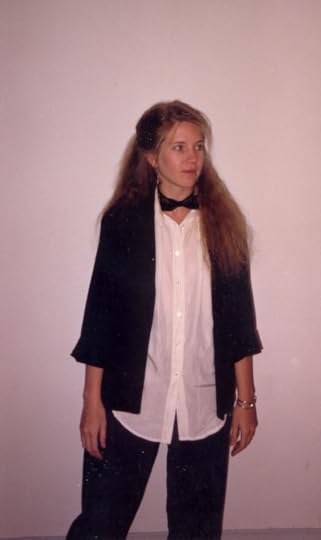 While we were apart. Kelley went to parties
While we were apart. Kelley went to parties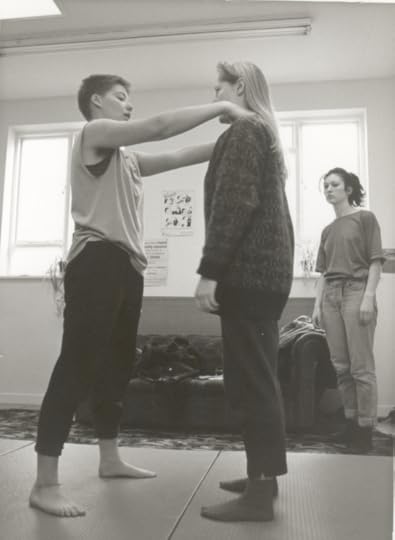 I worked every hour the universe sent teaching to earn $$
I worked every hour the universe sent teaching to earn $$That autumn we were apart, in 1988, was very, very hard. Kelley was working at GE Computer Services, going to parties, and making friends in the Atlanta queer community. In Hull, I was grief-stricken (my little sister died), stressed out of my mind (in love with two women on opposite sides of the Atlantic), and frantically earning money to get back to the US. As well as my actual job as a caseworker at a street-drugs agency (basically doing social work for people using heroin and meth), I was teaching women’s self defence as many evenings and weekends as I could. I hadn’t really started to get sick yet…
 1989—what is love without a cat?
1989—what is love without a cat?Then I did get sick. And I lost weight. But then, finally, I managed to get back to Kelley. I’m not sure we let go of each other for more than 5 minutes at a time the whole seven weeks I was in the US. This Polaroid was taken in Tampa, where Kelley introduced me to her mother and stepfather.
This time when I left her it was to return to the UK one last time, sell my house, leave my partner of 10 years, and say goodbye to my family. It took three months. It was hard.
We lived in a brand new apartment way outside Atlanta: Duluth, Georgia. Then moved closer into the city with a rented house in Decatur. Finally, with the advance I got from Ammonite, we had just enough to put down a scarily skimpy deposit and risk an adjustable rate mortgage on a little house in Atlanta itself. At some point I would either sort immigration and we’d move somewhere not so damned hot, or the immigration thing would completely implode and we’d have to leave the country. Either way, we’d be selling before the interest rate jumped too much. It was worth the risk. But money was tight, immigration was daunting, and my mysterious fatigue was not getting better.
 Stressed and tired we find refuge in each other. Photo by Mark Tiedemann.
Stressed and tired we find refuge in each other. Photo by Mark Tiedemann.In this photo, taken in 1992, the strain is showing. We were seeing lawyer after lawyer and not getting the immigration answers we needed. I was having medical test after medical test, ditto. We knew it was serious when I began to limp. Six months later, I had my diagnosis: MS.


Six months after that, we got married. I wore long sleeves because of all the IV bruises on my arms. But I was so happy that day. I don’t think we let go of each other at all except to hug other people. It was a home-made wedding; the whole thing, excluding the rings, cost $500.
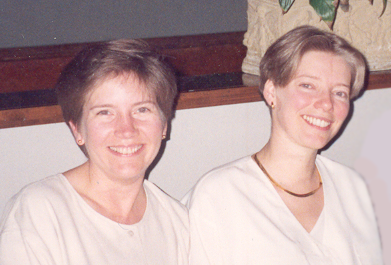 I started to let my hair grow
I started to let my hair growAlthough the marriage had zero legal force it had a profound effect on me. Weirdly, that manifested in me beginning to grow my hair. (Something about being settled? Being a wife? It’s a mystery.)
 Now we play grownup, or maybe dress-up: Southern Ladies Who Lunch
Now we play grownup, or maybe dress-up: Southern Ladies Who LunchAnyway, by the next spring it was long enough to spray and pin into an up-do for a big ol’ Southern party at my editor’s father’s house: everyone who was anyone in Atlanta society was there. It was like playing dress-up. It was playing dress up.
Then I sold another book (Slow River). I got my Green Card. And we moved to Seattle.
 1997 outside a friend’s house in Seattle
1997 outside a friend’s house in Seattle1997. Seattle. We are much more at home. Kelley has a fab job at Wizards of the Coast and I’ve published two novels and sold a third (The Blue Place). We have a lovely little house in Wallingford (that’s a friend’s house in the background). We’re bursting with happiness. One fly in the ointment: my hair. It’s long enough to plait, very heavy and very annoying. Here it’s scragged out of the way; I am sick of it.
 1999, Monteplier VT
1999, Monteplier VT 2000, Queens Grill, Queen Elizabeth II
2000, Queens Grill, Queen Elizabeth II1999. Vermont. I’ve started to shorten my hair; this was also th eyear I started using a cane. One year later, in 2000, I’ve chopped it all off and bleached it white. This is us in the Queen’s Grill onboard QE2: a transatlantic crossing that was our 40th birthday present to ourselves. We’re both wearing long dresses because they take First Class seriously on that boat. (Next time: a tux! At the time I didn’t know anywhere I could get one.)
 About to dance the Freedom Fandango
About to dance the Freedom Fandango 2002 at the PKD Awards
2002 at the PKD Awards2000 was a big year. My MS was increasing upon me and Kelley cashed in her stock options. Life was uncertain. We had no idea how many years of good life I, and so we, had left. Live life now, is what we decided. Kelley quit her job and we threw an enormous party—rented out a whole nightclub in Pioneer Square—called it the Freedom Fandango, and invited everyone we knew.
I underwent an experimental course of chemo. Felt brilliant. Felt terrible. Then stabilised. The second photo was taken after I’d stabilised again: me and Kelley at the PK Dick Awards with our friends Mark and Donna. I was there to support Mark, who was nominated, and to accept the award for Steve Baxter if he won—which he did. I was about to publish the second Aud novel, Stay. Kelley was about to publish her brilliant novel Solitaire .


‘Stabilised’ is always a relative term when it comes to MS. It’s actually a course of endless decline. By 2004 it was clear we would have to leave our beloved house-with-all-the-steps in Wallingford and find something more accessible. So here in 2005 is one last shot of Kelley making hummus in the kitchen of our old house. One of me in the kitchen of our new single-level house a month later in Broadview. Kelley has published Solitaire and just started the longest-ever negotiation for the movie rights. I’m working on Always.
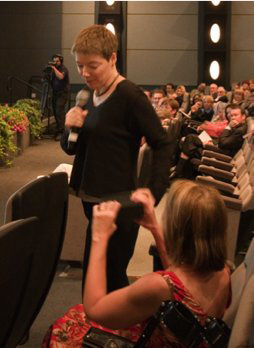 Los Angeles: Lammy #6
Los Angeles: Lammy #6 We were up late...
We were up late... Celebrating 20 years
Celebrating 20 yearsMay 2008 in Los Angeles: winning my sixth Lambda Literary Award (for And Now We Are Going to Have a Party). Then the day after in the bar feeling a leetle rough. Then June in Seattle: a dinner party at home to celebrate our 20th anniversary. I am about to start writing Hild. Kelley is writing the screenplay for OtherLife.
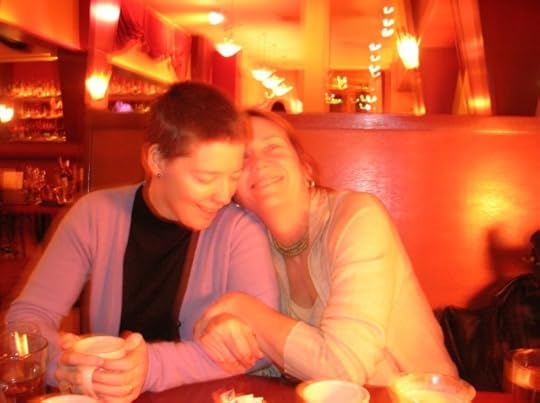
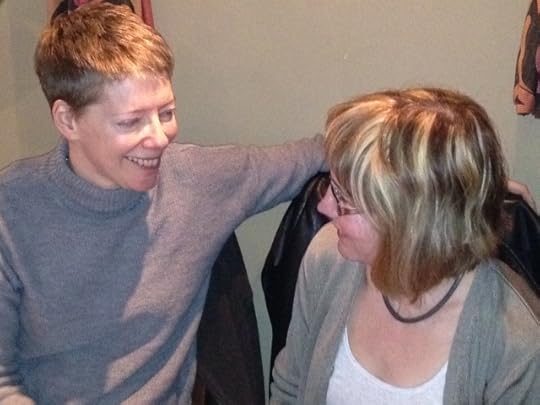

These are all taken between 2009 and 2012. The black and white one by Jennifer Durham is me being delirious with delight at getting an offer from FSG for Hild.


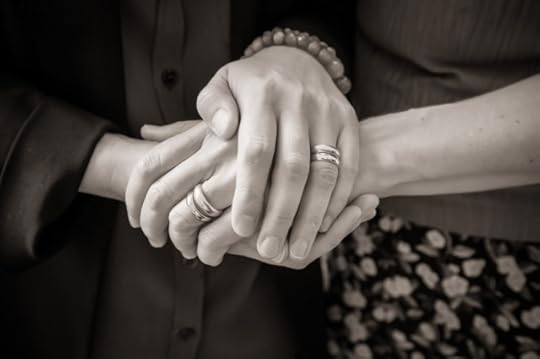
2013. General happiness, and then, a few months later, a fully legal wedding on the 20th anniversary of our first nothing-legal wedding. All these photos by Jennifer Durham, too.
 2013, as co-Guests of Honour at Westercon.
2013, as co-Guests of Honour at Westercon.In 2013 Kelley and I were co-Guests of Honour at Westercon. It was fabulous. We turned it into a mini Clarion reunion and had a splendid time. All that year, and the next, we travelled: a US hardcover tour for Hild, then a UK tour, then a US paperback tour, culminating in Washington DC for Kelley’s father’s 80th birthday.

In 2015 and 2016 I found myself in the news, a lot. In 2015 it was the unexpected whirlwind around the Literary Bias data I put together. In 2016 it was the even more unexpected resurrection of Anita Corbin’s Visible Girls series and then Visible Girls Revisited. It’s pretty weird being recognised for a random moment 43 years ago.
By this time I’d transitioned to using a wheelchair. I was ill and tired. Kelley was working staggering hours as a freelancer. We were dealing with a Lot of Family Stuff. This photo was taken by Anita for the new series; I don’t like the photo, perhaps because I feel as though I look heavy. (I’m not talking about physical weight but emotional weight.) And I was unhappy about the wheelchair. It’s hard to explain: I’m not unhappy about using a wheelchair—the wheelchair has given me a kind of freedom I had lost. I was unhappy about being posed with the wheelchair. It felt…weird. Sort of fetishistic. In fact I’ve cropped this photo because in the original the chair became the focal point.
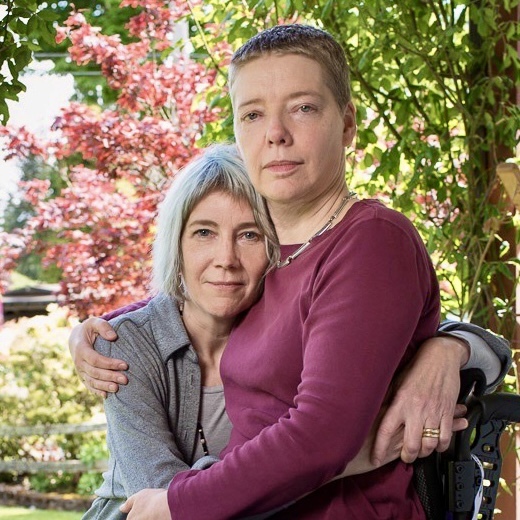 2019. © Anita Corbin as part of the Visible Girls Revisited series..
2019. © Anita Corbin as part of the Visible Girls Revisited series..Then it was the pandemic, and we went nowhere and took only endless photos of experiments with home hair cuts.
Then, woo-hoo, we started going to conventions again—specifically ICFA. Here we are in 2022 and 2023, loving the sun and the company.
 2022. Blurry photo by the pool
2022. Blurry photo by the pool 2023. A less blurry photo on the other side of the pool
2023. A less blurry photo on the other side of the poolSpear won awards and nominated for a bazillon more, and Menewood came out. And here we are at the World Fantasy Convention last year.
 Nov 2023, WFC. We’re in the bar—shocking, I know—I’m off camera to the left
Nov 2023, WFC. We’re in the bar—shocking, I know—I’m off camera to the left Nov 2023, WFC. We’re in the mass signing—Kelley’s off camera to the right
Nov 2023, WFC. We’re in the mass signing—Kelley’s off camera to the rightAnd here we are this time last year at the same event—Kelley at the pre-game wine-and-nibbles (I was doing the meet-and-greet with board members and donors at the other end of the room) and me on the stage an hour later.3
 Kelley listening to friends talk while I sing for my supper at the other end of the room
Kelley listening to friends talk while I sing for my supper at the other end of the room Me on stage getting intense about queerness in the Early Medieval while Kelley watches from the audience
Me on stage getting intense about queerness in the Early Medieval while Kelley watches from the audienceWe’re both tired. We’ve been through a lot of external stresses the last couple of years.4 But as you can see between the photos of te year before and then last summer we were beginning to get a lot of that sorted and the strain is easing. And, as always, we find our refuge each in the other—and the strength inside ourselves to be strong for the other when they can’t.
This last 12 months has been more difficult in health terms—but, again, recently the news has been encouraging—and, again, other stressful parts of our lives are improving. (Apart from, y’know, the occasional, Hey, we nearly died moment. And the even more recent week where every single one of our appliances—washer, dryer, stove, fridge—died at once.)
But also in the last 12 months some amazing things have happened: I was inducted into the SFF Hall of Fame, the Aud books have been republished in the US (and this time next week the UK), and earlier this month I SFWA honoured me with the 41st Damon Knight Memorial Grand Master Award. Kelley and I were in Kansas City together and did a lovely joint presentation as well as enjoying another mini Clarion reunion. Here we are at the banquet, before they let in the awards audience and before I go up on stage. The food, sadly, was awful but the company, as always, marvellous.
 Nebula banquet, June 2025. Photo by either Mark Tiedemann or K Acuna (sorry I can’t remember which)
Nebula banquet, June 2025. Photo by either Mark Tiedemann or K Acuna (sorry I can’t remember which)Kelley is the finest person in the world. I fell in love with her in a moment but have spent my life since then trying to be the person she deserves. I might never get there but it continues to be an amazing journey.
Little things like reason—everyone, even Kelley to begin with, thought I was, well, perhaps ‘not sensible’ is the kindest way to phrase it—family, my partner, friends, jobs, money, health, immigration law… ︎And thereby create new immigration law.
︎And thereby create new immigration law.  ︎So many photos these days seem to be taken at events where for one reason or another we can’t sit, as we prefer, right next to each other. We really, really have to fix that!
︎So many photos these days seem to be taken at events where for one reason or another we can’t sit, as we prefer, right next to each other. We really, really have to fix that!  ︎I wrote about that here and here.
︎I wrote about that here and here.  ︎
︎
June 24, 2025
New interview up at Strange Horizons
 Pat Cadigan
Pat Cadigan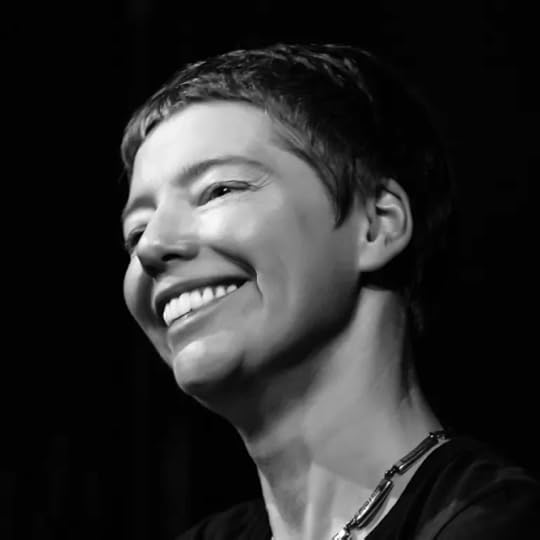 Nicola Griffith
Nicola GriffithOver at Strange Horizons there’s a new interview up with me and Pat Cadigan. Pat was born and grew up in the US and now lives in the UK. I was born and grew up in the UK and now live in the US. Pat and I published our first short fiction at about the same age—but on different sides of the Atlantic. That plus the fact that Pat’s a handful of years older than me but that the UK was always a few years behind on gender issues means that we have oddly parallel but rarely crossing experiences of being women in SF.
I’ve met Pat only twice in person and wish it could be more—I would love to have done this interview in person, with some cross-talk between us. In actuality, Kerry Ryan interviewed up separately but then spliced the answers together, and the result is an intriguing look at adjacent universes.
To whet your appetite, here’s a snippet from the beginning:
Kerry Ryan: Where did you find the confidence to write SFF at a time when the cultural climate wasn’t just discouraging but actively hostile?
Nicola Griffith: Psychotic self-belief! I knew from—I don’t even know how old I was—maybe as soon as I could spell my own name, that I was a dyke, and that meant I was never, ever going to be liked in that “ideal” way. Not as a nice Catholic girl. Not by my family, my church, my school, or the world in general at that time. There was no point trying to please people, because I never would, just because of who I am and the way I move through the world. It was impossible. So why bother trying? Why not aim for what I wanted?
Pat Cadigan: I grew up below the poverty line in what people called a “bad neighbourhood.” People would take one look at me and assume I’d get pregnant at fifteen, drop out, and end up in beauty school. That was the trajectory they imagined for girls like me.
My mother used to say, “People will see you as the child of a broken home. And if you get into trouble, they’ll blame me. So don’t screw up or I’ll kill you.” She was only half joking. But I had her as a model because we didn’t get abandoned by my father, we left him.
So that was my example: If things aren’t going the way you want them to, that’s just how it is—and so you fight. Either you get what you want, or you discover something else that’s worth wanting. What I saw growing up was women doing whatever needed to be done and not because they had money, or men, or family support, but because that was the only option. You want something? You make it happen.
And so we both did, in our different ways.
June 22, 2025
The head gardener expresses his disapproval
Our head gardener has most exacting standards: everything must be Just So. Specifically, everything must be Just So to please his visual aesthetic, to attract tasty beautiful hummingbirds and delicious crunchy ecologically-vital bees while also providing easy pouncing-distance visual access to said treats busy and useful pollinators.
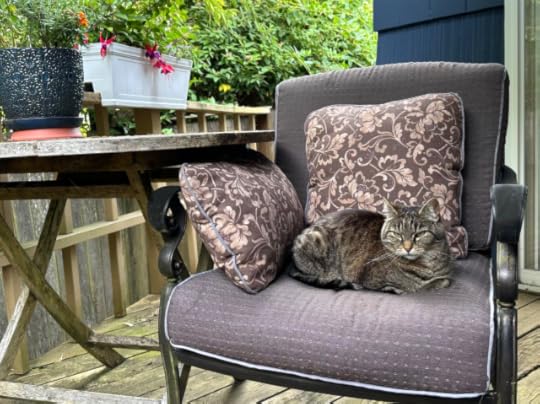 The head gardener is Not Pleased
The head gardener is Not PleasedWe are in fact doing our humble two-legged best to make our decks pleasant, useful, and safe for all its denizens. This year it involved rebuilding the hanging basket situation to dangle both the hummingbird feeder and the Hot Lips salvia they love so much a) close to each other and b) well above both the ground and the deck railings. And the hummingbirds love it.
Here’s another angle on that.
 Charlie can’t reach that feeder and he knows it. Unhappy kitty is unhappy.
Charlie can’t reach that feeder and he knows it. Unhappy kitty is unhappy.This video was taken while Charlie was sitting right there in that chair grumpy because he’s no fool—he knows he can’t reach the birds and he knows the birds know that. They taunt him—they don’t taunt George because George is too busy trying to work out how to surprise Boris and Natasha (the wild rabbits that love our front garden). Also, as pointed out to Charlie, “It’s insulting—they even stick their tongues out at us!”
Hummingbirds are deliberately leisurely in their feeding this year, pausing every now and again to stick out their tongues at the cats, Neener-neener-neener!We still haven’t quite finished planting but here’s what we have so far on the back and kitchen decks.
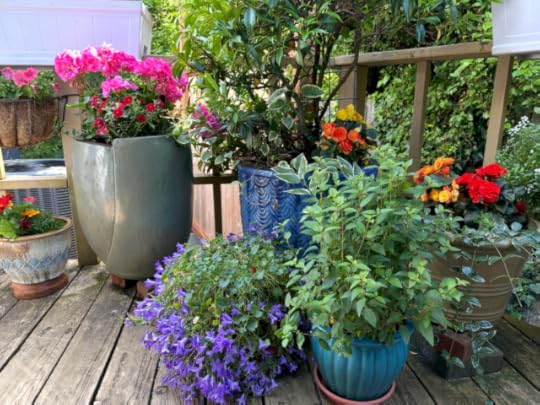 The corner of the kitchen deck—planted two days ago. Lots of growing still to be done.
The corner of the kitchen deck—planted two days ago. Lots of growing still to be done.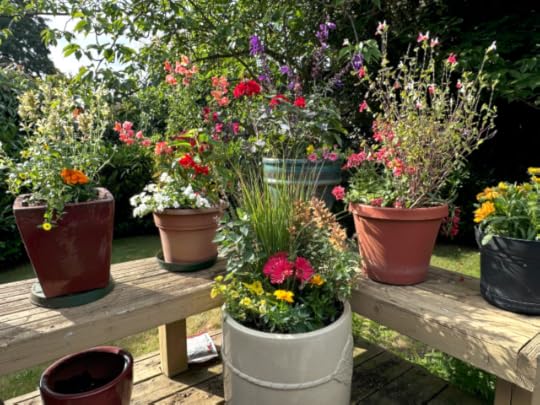 The corner of the back deck, also only just planted. More to come.
The corner of the back deck, also only just planted. More to come.Today is midsummer—announced in Seattle, appropriately enough, by torrents of rain. But the rest of the month and July will be prime growing weather. Expect an abundance of pictures of an abundance of blooms.
Meanwhile, Happy Sunday!
June 20, 2025
The Glory of a Grand Gong
The ‘gong’ in question being my Damon Knight Memorial Grand Master trophy. (I don’t have it in my possession right now; it weighs so much I had to get it shipped from Kansas City; but SFWA kindly sent me this photo of the award by K Acuna so I could talk about it anyway, which I wanted to do today, because here in Seattle, today is the summer solstice—at 7:42 pm to be precise. Happy Solstice!)
The Nebula Awards are designed afresh every year—and apparently the Grand Master award is unique to each recipient. I asked Russell Davis, who designed it this year, what all the bits and bobs in it were.
 Original photo b K Acuna
Original photo b K AcunaHe didn’t know what the orangey nebula swirl was made of, but for the rest:
Lapis Lazuli Sphere: I’ve always loved lapis—and that particular blue is Hild’s favourite colour. Lapis is also what helps prove that women wrote some of the earliest illuminated manuscripts: it was found in the dental tartar of nuns Early Medieval nuns; I’m guessing it got there when they licked their brushes to shape them into fine pointsTourmaline Shards: Blue and Black All I know about tourmaline is that in its cut and polished gem form it can polarise light—which makes it perfectly apt for several of my characters (Marghe, Aud, Hild, Peretur) whose many abilities all boil down to being able to see clearly, literally and metaphorically.Titanium Aura Quartz: I had to look this up. It’s not a natural mineral: apparently you make it by heating quartz to 871 °C in a vacuum, and then adding titanium and heating that until it goes through phase transition and coats the quartz.Black Jasper: I had no idea jasper came in black, so I looked it up and, well, it’s probably not actually jasper but a jasper-like stone, basanite or lydite. That is, a touchstone. Which couldn’t be more perfect. I’ll let you go read about it for yourself and figure out why.If I recall correctly from my one, bleary awards-night look, the closer you get to the stones the prettier they get. When the award finally arrives I’ll try get close-ups of each stone.
Now I’m trying to remember where I put my other Nebula—though I don’t think I ever knew what all the minerals in it were. I’ll see if I can dig it out for comparison purposes when its Grandmother arrives…
June 18, 2025
Video of my Grand Master speech
I tend to think speeches are better witnessed than read (though if you’d like to read it, the transcript is here), so here’s the recording of the speech currently up on YouTube. It’s cued-up to start with my speech, which last about 7 minutes, though of course feel free to watch the whole 2+ hour extravaganza. I don’t know how long the video will stay up on YouTube—maybe forever, maybe just for another couple of weeks. So, y’know, carpe video…
When you watch this, consider that these are not the clothes I thought I’d be wearing. I’d bought a spiffy suit at Nordstrom and had it tailored to fit. This turns out to be a complicated affair for two reasons. One, I’m in a wheelchair, and what looks good standing looks terrible when sitting in wheelchair shape. And two, it was a man’s suit—sold as a suit, not separates. And men are quite differently shaped to women. But the woman who was doing the alterations is a wizard, and understood exactly how to make it all work. She had fixed another jacket for me, and Kelley’s dress—we knew she was good at her job.
But timing was very tight. (Our lives are complicated at the moment—we have no time for anything—but that’s a long story for another time.) So three days before we flew I’d done only a preliminary test-fitting: the jacket was gorgeous, just right, but the pants needed properly finishing, including the hems. But as I say the tailor was very good; I was confident.
Sigh.
We picked up the suit the day before we flew, and there was no time to try it on (there was no time) so we just packed it, assuming all would be well. When we arrived we unpacked it and it was all creased up so we sent it to the hotel’s dry cleaners for pressing etc. Two hours before the banquet I finally tried it on. The jacket: still perfect. The pants: an absolute, unmitigated disaster. You could have fit two of me in them. I looked like a sad clown. Actually, a seriously pissed-off clown, but there was no point dwelling on the problem; we had to find a solution.
Fortunately I had separate linen trousers and knitted silk vest of blues dark enough to look like they matched, and I had that white jacket. So that’s what I wore. As I got dressed I was muttering grumpily but by the time we were going down in the elevator I’d let it go: what I was wearing was just fine. Not fine, as in sharp and sophisticated, but pretty good. And, more to the point, they were old friends: sublimely comfortable. Which in the end is what counts.
All’s well that ends well.

Now I just can’t wait to get hold of that big block of lucite that was too heavy to pack in the luggage for the flight back and finally get a proper look at it!
June 12, 2025
In exactly 3 weeks: Aud in the UK!
 The three Aud novels will be published in the UK by Canongate on 3 July. Pre-order
The three Aud novels will be published in the UK by Canongate on 3 July. Pre-orderBookshop.org | Amazon UK | Waterstones | WH Smith
In exactly 3 weeks the Aud trilogy will be published in the UK for the first time. It only took 27 years. I know I’m not exactly an impartial observer but these books really do kick ass. I love them with a crazy love. And I would dearly like UK readers to go preorder a copy.
Do you know any other queer noir/not-noir novels1 praised by Dennis Lehane, Val McDermid, Dorothy Allison, Lee Child, Manda Scott, Francis Spufford, Laurie King, Ivy Pochoda, Robert Crais, Elizabeth Hand, James Sallis and more? No? Then maybe you should go find out what brings together such disparate writers in their love.
You can pre-order now, or put a hold on the books at your local library. Enjoy!
Pre-orderBookshop.org | Amazon UK | Waterstones | WH Smith
They use some of the prose style of noir but they don’t do noir, in the sense that Aud, the protagonist, does not trap herself in an ever-downward spiral. The three books between them describe a hopeful arc—with, y’know, lots of sex, and scams, and seamy cityscapes. Aud, like Hild, has an essential joy in life no matter what tight spot she finds herself in… ︎
︎
June 11, 2025
Charlie and George help with flowers
This summer we’re behind on everything. Every. Damn. Thing. But we finally went to a nursery and bought a bunch of annuals to plant in our deck pots and the front flower bed. We have all kinds of bright deliciousness…
But, y’know, we’re behind. Charlie and George were on the back deck examining the pitiful state of the few survivors in pots from last year and Charlie decided it was time to sort us out—because there aren’t enough flowers to attract hummingbirds, and it’s not a fun summer without hummingbirds to leap at.

Charlie: Right then, George. Let’s just stride over to the other deck and get this done.
George: [sensibly silent]
As we all know, however, cats are not the most focused, hard-working beasties in the world. So when Charlie got to the other deck and saw the amount of work to be done, well, let’s just say is response was predictable.
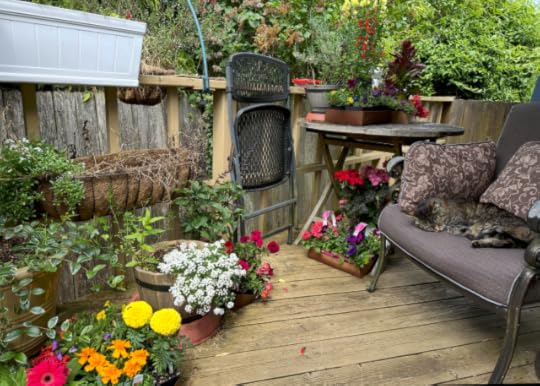
Sometimes just thinking about work can overcome a hero.
But never fear! We need to find some begonias—haven’t been able to find good ones yet this year—and then we will leap into action. Soon. Ish. And get those decks sorted. Stay tuned!
June 10, 2025
Grand Master Acceptance Speech
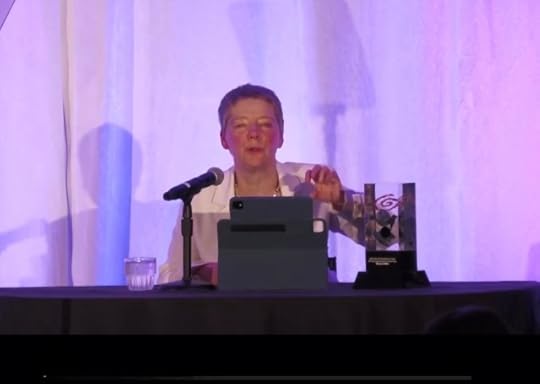 Screenshot from video of Nicola Griffith’s Grand Master acceptance speech, Kansas City, MO, 7 June, 2025.
Screenshot from video of Nicola Griffith’s Grand Master acceptance speech, Kansas City, MO, 7 June, 2025.A few days ago Kelley and I travelled to Kansas City to take part in the Nebula Awards Conference and for me to accept SFWA’s 41st Damon Knight Memorial Award.
I gave a speech. The speech was streamed live and recorded. In due time I’ll either post that video or link to it. Meanwhile, I’ve posted a transcript (below).
Giving speeches can be strange. It’s hard to predict the size and mood of the audience (in person and online) and difficult to gauge the sentiment ahead of time. The world is in a mercurial mood right now; it would be easy to get the vibe very wrong.
Regular readers already know I was hoping to do something a little untraditional with my few moments on stage and just hoped all those I owe the most thanks to forgave me.
I can’t answer for those people, but I can say I think the speech went down okay: I got a standing ovation that lasted until I packed up my iPad and wheeled down the ramp and got back to my table. I am happy and I am grateful.
Thank You — Kansas City, MO, 7 June, 2025Thank you. Ever since Kate first called I’ve been feeling this great, brimming sense of joy. You’re my people—being part of this community, part of SF, is where I feel as though I really belong. So this honour—it’s overwhelming. Thank you.
My very first SFWA event was in 1992, at the Nebulas in Atlanta. Kelley and I knew no one but we were welcomed with open arms and dragged around from group to group and introduced to everyone. I was amazed by the generosity—and that’s when I knew I wanted to belong here. SF is a culture of generosity—I’m guessing everyone in this room has helped and been helped by someone else here. No one does this alone. I certainly owe a lot to many people. And they deserve thanks.
And instead of taking these few minutes now to thank them, I’ve written a blog post. It’s either already live or will be soon. Please do read it—because I really want the people named to know how grateful I am. And I hope they’ll forgive me for not thanking them here, from the stage, because tonight, while I have your attention, I’m sure you’ll be shocked—shocked!—to hear I have a few things to say.
What I want to talk about is world-building, and what it really means.
Most of us here are writers but we’re all readers. I won’t speak for you but I turn to books for pleasure—whether we’re talking knowledge, or solace and reassurance, or vindication. As a kid, it was from books that I found out that there are other people out there who think trees are for climbing and axes for throwing and who look at other girls and want to kiss them. Books, story is where we turn to discover how it is to be human in all our shapes and circumstances. Story is where we turn for answers.
There are a lot of people out there right now who are looking for answers. I keep hearing the same lament: the world is terrible, I don’t understand what’s happening, I don’t know what to do. What can I do? This is how the world is now.
SF writers talk a lot about world-building, imagining and figuring out different societies, ecologies, and economies. But what writers do is so much more important, more powerful than that. We create story. And culture is built on story; culture is the shared story of who we are. The phrase ‘cultural producer’ isn’t a fanciful one; it’s what we do. We create culture. We create worlds—including this one.
It’s very easy to feel helpless if we think in terms of ‘this is just how the world is’. But the world is what we’ve made it. Which means we can unmake it, and remake it, make something better. We can imagine that better world and then build a working version, to show it’s possible.
To do that we have to be brave. Brave enough to leave the safety of the herd, the comfort of doing things the way they’ve always been done, and believing what we’ve always believed.
And then we have to help the reader be brave. Brave enough to let themselves imagine, brave enough to hope and dream. To find joy.
I think it can be really hard to imagine joy when we’ve been told misery and suffering is Just The Way of The World. But we—our stories—have the power to change that.
I’ve written, or am writing, fiction set in the past, the present, and the future, in worlds that maybe never were but perhaps could be. These are worlds where othered lives—queer lives, black lives, disabled or trans or underpaid and overworked lives—are just…lives. Lived by people. People with the same chance of joy as anyone else. That’s the key: that people find joy—or terror, or excitement—because of what they do or don’t do. Because of the decisions they make, how they behave, not because of who they are. Or who we’ve been taught to think they are.
If we do that, then readers can feel safe to let down their barriers, safe to risk imagining and living a life different to their own—perhaps one they’ve been taught is wrong or hard or dangerous. Safe to dream another’s dreams, learn another’s lessons, and feel an Other’s joy. Safe, while they’re immersed in story, to become someone else. Because if we do that, we can change how the reader thinks and feels about people who aren’t like them. Just for a little while. And sometimes a little while is all it takes. We can change the world, one reader a time.
That’s what I mean by world-building. It means to be brave. To see clearly. To not turn away. To name our reality, yes—and then to see past it, around it, or just go straight through it to what else might be out there that we’ve been trained not to see. There’s a reason many people sneer at ‘escapism’—dreaming is dangerous to the world order. As Tolkien said, those who tend to worry most about escape are the jailers.
So what kind of culture do you want to live in? What story are you going to tell? Go tell that story. I would love to see the world remade in the image of this community, of SF: a culture of warmth and generosity, a world where we all belong.
Thank you.
The award itself is very cool: made just for me; unique. When it arrives—it’s being shipped because it weighs at least 3 kg; there’s no way we could fit it in our luggage—I’ll post photos and explain the significance of all the nifty things embedded in the lucite.
June 7, 2025
Thank you
As you read this I’m on stage in Kansas City accepting the honour of becoming SFWA’s 41st Damon Knight Memorial Grand Master. Traditionally, those few minutes on stage are the new Grand Master’s opportunity to reflect on their career and thank all those who helped them on the way. I’ve chosen to do things a little differently.
First, I did the reflection-upon and lessons-learnt-from career stuff yesterday in a 90-minute conversation and AMA with Kelley and anyone in the room in person or virtually. Second, instead of gabbling a bunch of names without context in an effort to squeeze everyone in before the Nebula nominees expire from irritation and stress as they wait for me to just be done, and go away, so they can find out whether they’ve won, I’m going to thank people here, now. And third (and I’m sure regular readers of this blog will be shocked—shocked!—to hear it), I want to use those few precious minutes with the microphone to say a few things.
But we can talk about all that later. Right here and right now I want to thank people who have helped me in my writing career in ways great and small. There are a lot. I apologise to all those I’ve missed.
The first person who helped me was Carol, my partner for ten years in England, whose love and support were vital in those first years—who never once suggested I was unrealistic in trying to write books that won awards even though a) I didn’t know any writers b) had never studied writing and c) couldn’t even type—and didn’t even know you couldn’t submit manuscripts handwritten in blue fountain pen on lined paper.
The second person is, or perhaps was, a man I never met (and whose name I’m not entirely sure I remember correctly) at a publisher in London.1 When I was 23 or 24 I sent him a handwritten manuscript of a science fiction novel called Greenstorm, and instead of tossing the paper in the bin, or keeping it around to laugh over with his friends, he wrote back to me explaining all the very many things I’d done wrong—and suggesting the name of an editor who might actually like this book. Once it was typed. That was an act of extraordinary generosity. And it made a huge difference, because the name he suggested was Malcolm Edwards.
We’ll get to him in a minute. The next person to help was my mother, Margot Griffith.2 She didn’t approve of this novel-writing nonsense; she wanted me to get a real job. If I had to write, why not be a journalist—steady employment. Nonetheless when I explained that I needed to be able to type my book before I sent it out again, she bought me a secondhand IBM Selectric. And I got a book from the library and taught myself to touch-type.
David Pringle bought my first story, “Mirrors and Burnstone”—that is, the fourth story I’d written and sent him. He supported my career for years, first at Interzone and then by hiring me to write for Games Workshop’s Warhammer Fantasy universe.
Malcolm bought Ammonite—a first, mass market paperback from a complete unknown. That in itself isn’t unheard of; what amazes me is how much attention and how many publisher resources he used to launch it. He got me radio interviews, newspaper reviews, he put me—and my mother—up at the Groucho Club for three nights. And he basically let me suggest the design for that very first cover and found an artist who could realise my vision. And then he bought Slow River.
In between selling “Mirrors and Burnstone” and Ammonite, I met Kelley at Clarion. She’s the one I owe most to, but there isn’t a blog post in the world long enough to list all the ways. Instead, I’ll name the other workshop people I met there. Obviously the friends I made and still see—Mark Tiedemann, Brooks Caruthers, Daryl Gregory—but also all those I lost touch with but still think about sometimes. (If you’re reading this, please say hello!) Then of course there were the teachers. Tim Powers was the one who taught me when to really give your opinion of another writer’s book and when to be blandly polite—also, he brought beer! Lisa Goldstein brought into focus for me what it means to speak your mind at the right time. Chip Delany pretty much saved the experience for me: he found me food I could eat (I was starving), bought it, and brought it to my room; he made me feel less alien (another queer person!); and he introduced to me a writing concept that Kelley and I have refined and now call narrative and emotional grammar. Stan Robinson was the one who told us that writing should not be showy for its own sake: that good prose should be the feather on the arrow that sinks into the reader rather than a feather in the writer’s cap.3 And then there is Kate and Damon. Obviously I owe them the most. Even before Clarion I’d read their work—Damon Knight’s criticism as much as his fiction and soaked it up like a sponge. Kate Wilhelm—despite all her awards—was criminally underrated. But the thing I really owe them was their anger at my waste of talent.
Let me explain. I’ve always been a good writer—and I knew it. But while I knew I was good I never took it seriously: I played with it; I was clever with it; if something didn’t immediately work I gave up and moved onto to something else. And, hey, if writing didn’t work then I’d find something else. (Even going to Clarion itself was a toss-up: I’d also applied for a 4-week women’s martial arts camp in the Netherlands-it was just luck that Clarion wrote back first and offered me a scholarship.) When we had our teacher/student conference they offered me a plastic cup and some wine—a gallon jug of Gallo; I’d never tasted anything as awful in my life, but they thought I was going to need it; they were right—and then tore into me. Minute after minute they smacked me about, coming from different directions with each sentence, but what it boiled down to was this: they were really, really angry that I was wasting my talent. They set aside my submission stories (Mirrors and Burnstone, and Down the Path of the Sun) then lifted the stack of workshop stories and tossed them on the floor. They were disgusted. Why? Why was I writing such unserious crap when I could write stories like Burnstone and Path of the Sun? How dare I? How dare I waste my time, their time, and my talent when there were people in that workshop who would kill for a tenth of what I was just frittering away? On and on, minute after minute—Damon getting louder; Kate red in the face. What, they shouted, was I afraid of? I stood there, quite blank, and then they told me to just go away, and come back when I had something to say.
I went away and spent the afternoon and early evening drinking beer and thinking. They were right. I’m still not sure ‘afraid’ is the right word, but it’s not entirely the wrong one. either. I hadn’t committed; I wasn’t taking the work seriously; uncharacteristically (why?) I wasn’t stretching to my limit, I wasn’t taking risks. I wasn’t reaching with all my will and focus. I wasn’t being brave.4 That conversation changed my trajectory; I owe Kate and Damon a lot.
In UK: two local fans introduced me to the Hull SF community (via a ritual viewing of ST:TNG) they told me about an sf festival in Beverley, where I met Gwyneth Jones and Lisa Tuttle. I also met Brian Aldiss—but that’s a whole other story…
—and then I met some of the Leeds SF community, including Charlie Stross—to whom my first words, sadly (it’s a long story—I’ll tell it some day), “Oh, just fuck off!” (Things improved from there.)
After Beverley where I met so many people who wished there was something like Clarion in the UK, I thought, Well why not make one? And created the first SF writers weekend funded by Arts Council Britain—and invited Lisa and Iain Banks to teach alongside me.
After that I was invited to Mexicon—where the idea for Ammonite fell into my head in the middle of a panel moderated by Sherry Coldsmith—thank you, Sherry!—-about women as aliens—and realising M&B’s ‘aliens’ were, in fact, women.
Then I moved to the US and the immigration struggle began—while I left the country every six months and came back two weeks later on another tourist visa. I started freelancing under the table (because tourist visa) for southern voice. I reviewed. Lot of books. I interviewed Dorothy Allison about Bastard Out of Carolina over the phone (and nothing recorded, so i had to recreate the whole thing from memory) then met her face to face at Charis books—and discovered she not only wrote the best queer fiction, poetry, and essays, she also loved SF. She became my friend and champion ever after. I miss her still.
It was at Charis Books (thank you, Linda Bryant!) that I met Ursula and told her about the Ammonite sale and asked for a blurb (yes I did). And she gave me one—and put me in touch with Vonda McIntyre, who also gave me a blurb.
More than that, Vonda introduced me to her agent, Fran Collin—who got me offer from Gordon Van Gelder at St Martins for a hard/soft deal for Ammonite with Avon. Against all advice, I turned them down (another loooong story, told elsewhere—but it put my name out there) and instead sold Ammonite to Ellen Key Harris at Del Rey.
In 1992 at the Nebulas in Atlanta—that’s when things really kicked into gear because that where Ellen Datlow said, Oh *you’re* Nicola Griffith! Let me introduce you to everyone. And she did—and it’s also where I met Ed Hall—great friend who helped later.
It was right around this time that I also met Dave Slusher, who interviewed me several times for his college radio station.
Meanwhile, at Del Rey, Ellen Harris, a brand new associate editor and me, a brand new writer, threw away the rule book and invented a guerrilla marketing campaign which led to awards right out of the gate, plus what might have been the first review of a mass market paperback original in the NYT—and it was a great review.
One of the awards was the Tiptree, and I went to Readercon for it—where I met a zillion people—and at Wiscon—ditto. Ellen and Delia, Jeanne Gomoll, Ellen Klages, so many more.
My second agent, Shawna McCarthy, sold Slow River to Del Rey (another loooong story) and again to Malcolm.
When I sold Slow River to Del Rey I met the associate publisher, Ku Yu Liang, who, in an extraordinary move, sent me and Kelley (all expenses paid) to ICFA—where I met so many peopleI’d already met (including Brian Aldiss)—and many others such as Gary Wolfe and Joe and Gay Haldeman—for the first time.
All this time the immigration fight was going on, and for that I want to thank Allen Ginsberg, Stan Robinson, and Zell Miller,the then-governor of Georgia (!!) and of ourse the goddess of immigration attorney, Carolyn Soloway. I got my Green Card—but not before having to make new law.
Then we moved to Seattle. And here I met and was helped by so very many people—and time is running short—that I’ll have to just start listing names. Obviously top of the list, the mover and shaker behind everything, is Vonda McIntyre. She made so much possible. Also Eileen Gunn and John Berry, Nisi Shawl, Octavia Butler, Ursula again and more, Robin McKinley, Nancy Kress, Timmi Duchamp, Greg and Astrid Bear, all the folks past and present at Clarion West, Ted Chiang and Marcia, Matt Ruff and Lisa, Neal Stephenson and Ellen, Kathy Cain and Charles Mc Aleese, and so many booksellers: Rick, Tom, Rob, Duane, Fran…
Then there’s Janis Ian, Stacey and Mary, Kate and Liz, Laura and Amy, Jen and Therese, and so many, many more…
But always, the SF community—all those parties at our house, Vonda’s house, Kate and Glen’s house. You know who you are. Thank you.
Somewhere in there I met Colleen Lindsay, and in 2000 she introduced me to Sean McDonald, the an editor at Nan A. Talese. He is my editor still—though now at FSG—so obviously I owe him a great deal.
In 2007 I met Maria Dahvana Headley—and she introduced to my current agent Stephanie Cabot. Stephanie and Sean between them changed my career.
Oh, and now time is really ticking by. So to my family and friends and neighbours and colleagues I haven’t yet named—Anne and Julie, Jennifer Durham (photographer extraordinaire), Liz Butcher, friend beyond price, Angelique and Liliana, Stacey and Mary, Ginny and Lynn, Bob ad Tina, Vicki, all the teams at Gernert and SLA and FSG/MCD, and now—yay!—at Canongate, thank you.
I couldn’t have done any of this without you.
Thank you. And there are still so very many more but right now I have to go get dressed in my nice blue suit and go make a speech…
Thank you!
 ︎My father never helped me in my writing. He actively hindered it and sneered at my efforts. He only ever read on thing I wrote, a very early story, “We Have Me the Alien,” and his only comment was, There’s no ‘e’ in lightning. He told me I should give up, that I would never be published, I was pathetic for trying. I walked right u to him—came very closer to hitting him—and said through gritted teeth, I fucking well will. Watch me and stormed out, slamming the door so hard a picture fell off the wall. A few years before he died he did become very proud of me—proud of my work. Proud of my PhD. Better late than never.
︎My father never helped me in my writing. He actively hindered it and sneered at my efforts. He only ever read on thing I wrote, a very early story, “We Have Me the Alien,” and his only comment was, There’s no ‘e’ in lightning. He told me I should give up, that I would never be published, I was pathetic for trying. I walked right u to him—came very closer to hitting him—and said through gritted teeth, I fucking well will. Watch me and stormed out, slamming the door so hard a picture fell off the wall. A few years before he died he did become very proud of me—proud of my work. Proud of my PhD. Better late than never.  ︎This is a metaphor I’ve so used so many times that I’m no longer certain where I got it from. But I think it was Stan—or at least I think he said something very like it.
︎This is a metaphor I’ve so used so many times that I’m no longer certain where I got it from. But I think it was Stan—or at least I think he said something very like it.  ︎The need for bravery matters. I’ve talked about it before, several times, and one day I’ll write about it at length. But not here.
︎The need for bravery matters. I’ve talked about it before, several times, and one day I’ll write about it at length. But not here.  ︎
︎
June 3, 2025
Aud Day!

Today is the day you can go into your local bookshop and buy all three Aud novels in lovely matching editions. And you should do that. Why? Well, look at the photo: the cats are trying to point something out to you.
Do you see it? Not? Okay, how about now?

And if you still can’t see it then, well, never mind. Just enjoy these quotes instead.
